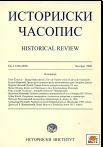Сеоско професионално занатство Кнежевине Србије (1834-1866)
Professional Rural Handicrafts in the Principality of Serbia (1834-1866)
Author(s): Bojana Miljković KatićSubject(s): History
Published by: Istorijski institut, Beograd
Keywords: rural handicrafts; Serbia; 19 century; professional; Oriental crafts
Summary/Abstract: Professional rural handicrafts were present back in the period of the first rule of Prince MilošObrenović, although both villages with established handicraft production and craftsmen in them were low in numbers. In the course of the next three decades the total number of craftsmen increased, but crafts they were involved in remained almost the same in numbers. These were the Oriental crafts which were present in the urban environment as well, and that was the situation causing jealousy between urban and rural craftsmen. Notwithstanding that rural artisanship mostly met the needs of rural population and that the rural handicraft market was limited mostly to surrounding villages, their access to the respective nearby town markets resulted in the long standing effort, made by both urban craftsmen and their guilds, aimed at getting rural craftsmen incorporated into guilds or moved to towns. Rural craftsmen played a marginal role in economic life of Serbia, both in numbers and regarding their economic power measured by its share in the economic system of the country. In the economy of local communities, however, they were principal promoters of endeavors aimed at getting the status of towns granted to villages with more notable numbers of craftsmen, and therefore aimed at giving them a chance to develop faster. These endeavors were distinct until the middle of 19th century, when rural artisanship became fully professional, being already developed enough to make rural craftsmen able to support themselves almost entirely by handicraft production. In the course of thirty years or so (from 1834 to 1866) the structure of rural handicrafts remained unchanged – the majority of craftsmen were involved in the Oriental crafts, working in service industry without ancillary labor engaged, as they used to in the times of Prince Miloš. Total number of craftsmen, however, increased, and they gradually concentrated into little craftsmanship centers, set up mostly within municipality centers or inside settlements that had already been towns back in the times of full Ottoman rule in the Belgrade Pashalic.
Journal: Историјски часопис
- Issue Year: 2013
- Issue No: 62
- Page Range: 309-329
- Page Count: 21
- Language: Serbian

